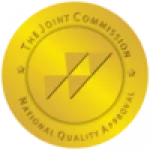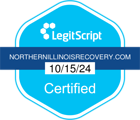August 31st is International Overdose Awareness Day, and it’s more important than ever to know the impact overdoses have on individuals, their families, and their communities. Opioids account for the vast majority of overdose deaths, and overdoses are now the leading injury-related cause of death in the United States. Opioid abuse continues to be a widespread issue across the United States, affecting individuals, families, and communities.
Addressing the root causes of opioid addiction is crucial in preventing overdoses. This includes improving access to mental health services, addressing social determinants of health (such as poverty and homelessness), and promoting alternative pain management strategies to reduce reliance on opioids.
At Northern Ilinois Recovery Center in Crystal Lake, Illinois, we pride ourselves on providing our clients with a continuum of care that leads them to a successful recovery. We provide comprehensive addiction resources such as opioid abuse prevention techniques to help break the cycle oof addiction, and reduce the dangerous rates of drug-related overdoses and deaths.
What is an Opioid Overdose?
An overdose occurs when a person consumes a higher amount of opioids (or other drugs) than their body can handle. It leads to a severe and potentially life-threatening reaction. Opioids in particular suppress the central nervous system, affecting vital functions like breathing and heart rate. Therefore, an overdose can cause respiratory distress, organ failure, and death.
It is important to note that an opioid overdose can happen to anyone, regardless of their age, gender, or socioeconomic status. Surviving an overdose can also lead to withdrawal symptoms, which may include anxiety, nausea, and muscle pain.
Combating the Overdose Epidemic
The opioid overdose epidemic has become a major public health crisis. To combat this crisis, various initiatives and strategies have been implemented at local, state, and national levels. These initiatives focus on preventing substance misuse, treatment, and support for individuals struggling with opioid addiction.
Limiting exposure to opioids is incredibly important to preventing overdoses, both from legal prescribers and in cracking down on illegal distributers. Naloxone is a life-saving drug that can be administered nasally or via injection, quickly restoring normal breathing to a person experiencing an overdose. Many states have implemented programs to distribute naloxone to first responders, community organizations, and even directly to individuals at risk of overdose. By ensuring widespread availability of naloxone, more lives can be saved in the event of an overdose emergency.
Overdose Statistics for the US and Illinois
In the United States, more than 107,941 overdose deaths occurred in 2022 alone, with opioids being involved in three-quarters of cases. Many individuals who suffer from opioid overdoses are also dealing with substance use disorder, a chronic condition that requires comprehensive treatment.
Illinois is also significantly impacted by the opioid crisis, with thousands of overdose-related deaths each year. From 2021 to 2022, the state experienced a 5.1% increase in overall overdose deaths, with opioid overdoses increasing by 8.2%. Fentanyl is a synthetic opioid, which is arguably one of the most deadly drugs, whose death toll rose by 12.1%, and is still increasing.
It is crucial to recognize that behind each statistic lies a personal story of struggle and loss. Families and communities are deeply affected by the devastating consequences of substance abuse and addiction. The ripple effect of an overdose extends far beyond the individual, impacting loved ones, friends, and even entire neighborhoods.
How Illinois is Helping to Fight Overdose
 Illinois has taken significant steps to address the opioid crisis and reduce overdose rates. The state has implemented various programs and policies aimed at prevention, treatment, and harm reduction. These include increasing access to naloxone, a medication that can reverse the effects of an opioid overdose. Illinois also has the Good Samaritan Law in place, which ascribes a limited immunity to prosecution of drug possession (to a point) for people who call 911 or bring a person to an emergency room for help with an overdose.
Illinois has taken significant steps to address the opioid crisis and reduce overdose rates. The state has implemented various programs and policies aimed at prevention, treatment, and harm reduction. These include increasing access to naloxone, a medication that can reverse the effects of an opioid overdose. Illinois also has the Good Samaritan Law in place, which ascribes a limited immunity to prosecution of drug possession (to a point) for people who call 911 or bring a person to an emergency room for help with an overdose.
One key initiative in Illinois is the Prescription Monitoring Program (PMP), which tracks controlled substance prescriptions (up to Schedule V) to prevent misuse and diversion. Healthcare providers can access this database to ensure safe prescribing practices. There have also been state-wide initiatives designed to lower the barriers to establishing sites for accessing clean and safe syringes, as part of overall harm reduction.
Signs of an Overdose
Recognizing the signs of an overdose is crucial in taking prompt action to save someone’s life. Common signs include:
- Extreme drowsiness or difficulty staying awake
- Slow or erratic pulse
- Slow or shallow breathing
- Blue or ashen skin, particularly on lips or fingertips
- Unresponsiveness or inability to be awakened
- Pinpoint pupils
If you observe any of these signs in someone who has been using opioids, it is essential to seek help immediately.
What to Do If Someone Has an Overdose?
In the event of an overdose, time is of the essence. Acting quickly can save a life. If you suspect someone is experiencing an overdose:
- Call 911 or your local emergency number immediately.
- Administer naloxone if available and follow the directions provided.
- Perform rescue breathing if the person is unresponsive or not breathing.
- Stay with the person until medical professionals arrive.
Remember, seeking medical help without delay is crucial in the event of an overdose. For additional support, individuals can contact SAMHSA’s National Helpline, a free, confidential, 24/7 information service that provides referrals to local treatment facilities and support organizations.
Causes and Risk Factors of Overdose
Understanding the causes and risk factors associated with opioid overdoses can help in prevention efforts. While overdoses can happen to anyone using opioids, certain factors increase the likelihood of an overdose occurring.
Some common causes and risk factors include:
- Misuse of prescription opioids or taking higher doses than prescribed
- Individuals who take prescription opioids, especially without constant medical supervision, are at risk of developing opioid dependence and tolerance, which can lead to overdose
- Using opioids in combination with other substances, such as alcohol or sedatives
- Purchasing opioids from illicit sources with unknown potency
- Previous history of overdose
By being aware of these causes and risk factors, individuals can make informed decisions regarding opioid use and take appropriate preventive measures.
Factors that Increase the Risk of an Overdose
Several factors contribute to an increased risk of opioid overdose. These factors include:
- Tolerance: Individuals who have built a tolerance to opioids may require increasingly higher doses, which can lead to developing opioid use disorder and increase the risk of overdose.
- Polydrug use: Mixing opioids with other drugs, including drinking alcohol or benzodiazepines, significantly increases the likelihood of an overdose.
- Inconsistent purity: Illicitly obtained opioids can vary in potency, making it difficult to gauge a safe dose.
- Age and health status: Older individuals and those with certain medical conditions may be more susceptible to the effects of opioids, increasing the risk of overdose.
- Chronic pain: Individuals suffering from chronic pain often use opioids for long-term pain management, which can increase the risk of developing tolerance and dependence, leading to a higher risk of overdose.
Understanding these risk factors is essential in taking proactive measures to reduce the chances of an overdose occurring.
How to Help Prevent Overdose
 Prevention plays a vital role in reducing the impact of opioid abuse and overdose. There are steps individuals, communities, and healthcare providers can take to help prevent overdose:
Prevention plays a vital role in reducing the impact of opioid abuse and overdose. There are steps individuals, communities, and healthcare providers can take to help prevent overdose:
- Education and awareness: Educating oneself about opioids, their dangers, and overdose prevention can help individuals make informed decisions. Educational programs focused on preventing drug abuse can equip individuals with the knowledge and skills needed to avoid substance misuse.
- Safe disposal of medications: Properly disposing of unused or expired medications reduces the risk of misuse or accidental ingestion.
- Utilizing prescription drug monitoring programs: These programs enable healthcare providers to closely monitor patients and identify potential issues with opioid use.
- Supporting access to treatment: Increasing access to evidence-based treatment options for substance abuse can greatly reduce the risk of overdose.
- Evidence-based treatment: Implementing evidence-based treatment methods ensures that individuals receive the most effective care, reducing the likelihood of overdose.
By implementing these prevention measures, we can make a difference in reducing opioid-related overdoses.
How to Reduce the Risk of Overdose
Reducing the risk of overdose begins with taking proactive steps. Individuals who use opioids can take the following precautions:
- Follow opioid prescription instructions: Always follow the prescribed dosage of your opioid prescription and do not take higher doses without medical supervision.
- Avoid mixing substances: Combining opioids with other substances, including alcohol and sedatives, can lead to a dangerous interaction.
- Seek professional help for substance abuse: If struggling with opioid addiction, seeking professional help is crucial in reducing the risk of overdose.
- Access overdose prevention resources: Familiarize yourself with local resources, such as naloxone availability and overdose prevention programs.
Implementing these risk-reduction strategies can go a long way in protecting individuals from the dangers of opioid overdose.
Remember: Opioid use disorder and overdoses are preventable
It is essential to remember that overdoses are preventable. It’s important to stay educated about the effects of opioids, what overdose can look like, and what to do in case of an accidental overdose. Abuse prevention is achieved by spreading knowledge and improving multiple aspects of society. But it’s possible to prevent the prevalence of overdose deaths.
Receive Help for Drug Addiction at Northern Illinois Recovery Center
If you or someone you know is struggling with drug addiction, Northern Illinois Recovery Center is here to help. As a leading addiction treatment center, our compassionate team offers comprehensive and personalized care to support individuals on their journey to recovery. Reach out today and take the first step towards a healthier, drug-free life.




